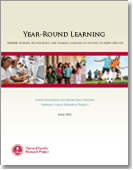 Harvard Family Research Project/June 2011 In 2001, Cincinnati Public Schools (CPS) launched the Community Learning Center initiative to turn its schools into “hubs for community services, providing access for students and families to health, safety, and social services, as well as recreational, educational, and cultural opportunities.”13 At the same time, CPS leadership invested $1 billion in equipping every school with the infrastructure necessary to support this broad range of services through a Facilities Master Plan to rebuild or renovate every school in the district. While site-based governance was already in place through Local School Decision Making Committees (LSDMCs), in order to create these new community learning centers, each school and its surrounding community engaged in a comprehensive planning process to develop the vision, assets, needs assessment, and priorities specific to the culture and wishes of each neighborhood. Each community oversees the selection of partnering agencies and maintains ongoing governance of the community learning centers.
Harvard Family Research Project/June 2011 In 2001, Cincinnati Public Schools (CPS) launched the Community Learning Center initiative to turn its schools into “hubs for community services, providing access for students and families to health, safety, and social services, as well as recreational, educational, and cultural opportunities.”13 At the same time, CPS leadership invested $1 billion in equipping every school with the infrastructure necessary to support this broad range of services through a Facilities Master Plan to rebuild or renovate every school in the district. While site-based governance was already in place through Local School Decision Making Committees (LSDMCs), in order to create these new community learning centers, each school and its surrounding community engaged in a comprehensive planning process to develop the vision, assets, needs assessment, and priorities specific to the culture and wishes of each neighborhood. Each community oversees the selection of partnering agencies and maintains ongoing governance of the community learning centers.
Community Learning Centers have overcome and challenged barriers to learning by aligning programs, partners, and services to support children and youth all year long. Nearly every school in CPS has been redesigned and is open for extended hours and year-round with programming and resources that reflect the needs of the neighborhood. As one observer notes, “It’s completely customer-driven.” For example, one component of the Facilities Master Plan was the creation of space within schools for health clinics. Some communities chose to utilize separate entrances to keep clinics open for extended hours. One school, which sees overcoming physical and mental health challenges as particularly important for student and community well-being, partners with a local pharmacy, primary health care provider, oral health care provider, and a behavioral health clinic to provide services through this space. Communities have also created new K–12 programs, a Montessori program, a museum school, and a community arts center. These investments of community resources are designed to create the conditions necessary for learning, to enhance academics, and to revitalize the surrounding neighborhoods.
Benefits across community learning centers have included higher attendance rates, reduction in disciplinary incidents, improved academic performance, greater parental involvement, and even an influx of young middle-class families who want to send their children to the neighborhood schools.
